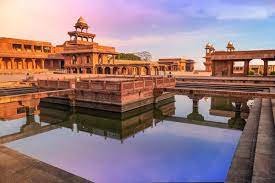India, a land steeped in history and culture, boasts a wealth of architectural marvels that stand as testaments to the grandeur of its past. From the ethereal beauty of the Taj Mahal to the formidable presence of the Red Fort and the soaring heights of the Qutub Minar, these iconic monuments have captured the imagination of people around the world. Join us on a virtual journey as we explore the historical significance, architectural brilliance, and cultural importance of these timeless treasures.
Our first stop on this captivating voyage is the Taj Mahal, an architectural masterpiece and one of the Seven Wonders of the World. Built by the Mughal Emperor Shah Jahan in the 17th century as a mausoleum for his beloved wife Mumtaz Mahal, it is a symbol of eternal love. The Taj Mahal’s pristine white marble facade, adorned with intricate inlays of precious gemstones, mesmerizes visitors with its sheer elegance. Its symmetrical gardens and reflecting pools create a serene ambience, inviting contemplation and reflection.
Moving on, we arrive at the majestic Red Fort in Delhi, a UNESCO World Heritage Site. Constructed by the Mughal Emperor Shah Jahan, it served as the imperial residence of the Mughal dynasty for nearly two centuries. Its imposing red sandstone walls, stretching over two kilometers, enclose a complex of palaces, pavilions, and gardens. The Diwan-i-Aam, or Hall of Public Audience, witnessed the grandeur of Mughal assemblies, while the Diwan-i-Khas, or Hall of Private Audience, hosted intimate gatherings and diplomatic receptions. The Red Fort stands as a reminder of India’s rich history and the architectural prowess of its builders.
Our final destination takes us to the Qutub Minar, an architectural marvel that dominates the skyline of Delhi. Standing at a height of 73 meters, this UNESCO World Heritage Site is the tallest brick minaret in the world. Built in the 12th century by Qutub-ud-din Aibak, the founder of the Delhi Sultanate, it represents the fusion of Indo-Islamic architecture. The Qutub Minar’s intricate carvings and inscriptions tell the story of its creation and the cultural exchanges that shaped India’s history.
Beyond their architectural splendor, these monuments hold immense historical and cultural significance. They bear witness to India’s rich heritage, reflecting the diverse influences that have shaped the nation over the centuries. They are reminders of the artistic brilliance and craftsmanship of the people who created them, as well as the empires and dynasties that ruled India.
Moreover, these monuments serve as magnets for tourists from around the world, drawing visitors to experience the magic of India’s past firsthand. The Taj Mahal alone attracts millions of visitors each year, who come to marvel at its beauty and immerse themselves in its timeless aura. These iconic landmarks are not merely structures of stone and mortar; they are living embodiments of India’s history and culture.
India’s iconic monuments such as the Taj Mahal, Red Fort, and Qutub Minar stand as testament to the nation’s rich heritage and architectural brilliance. Each of these landmarks has a unique story to tell, captivating visitors with their historical significance and awe-inspiring beauty. As we explore these timeless treasures, we gain a deeper appreciation for the cultural tapestry of India and the remarkable achievements of its past civilizations. Let us embark on this virtual journey and uncover the magnificence that awaits within the hallowed walls of these architectural marvels.




